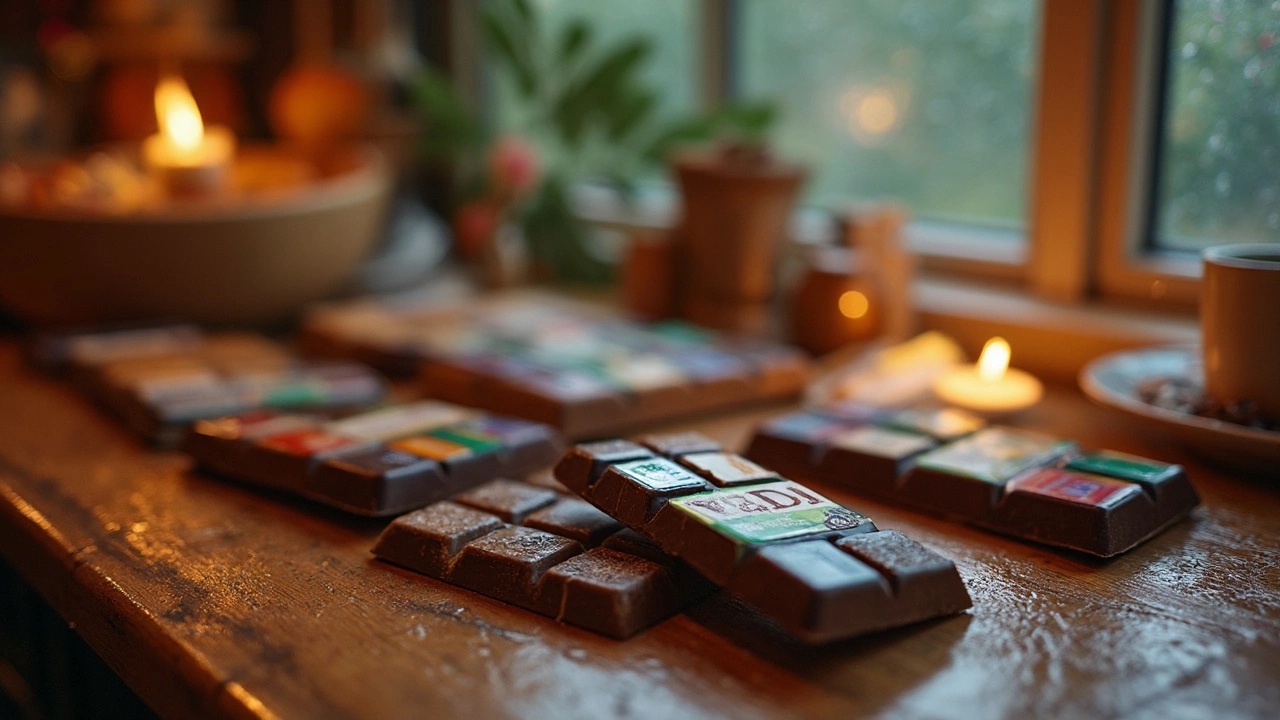
Chocolate. It's the ultimate indulgence, right? But if you're following a vegan lifestyle, it gets a bit tricky. You can't just grab any chocolate bar off the shelf. Many chocolates, although delicious, are sadly not vegan. The main culprit? Milk! And it's not just in your typical milk chocolate.
You'd think dark chocolate is safe, but surprise, surprise—it often contains milk powder or other sneaky animal-derived additives. It's like playing a game of hide and seek but with ingredients. Frustrating, huh? So, the question becomes, how do you spot a genuinely vegan chocolate among rows of tempting bars?
First things first, read those labels meticulously. Look out for words like 'milk solids', 'casein', or 'whey'. If you spot any of these, put that bar back—it's not your friend. Luckily, there are plenty of vegan-friendly chocolates around once you know where to look. High cocoa content dark chocolates are usually a safe bet, but double-check the ingredients to be sure.
- Understanding Chocolate Basics
- Common Non-Vegan Ingredients
- Surprising Milk in Dark Chocolate
- Identifying Vegan Chocolate
- Vegan Chocolate Alternatives
- Tips for Enjoying Chocolate as a Vegan
Understanding Chocolate Basics
Before diving into why chocolate may not be vegan, let's get to grips with what chocolate is made of. Chocolate originates from cacao beans, which are processed to create cacao mass, also known as chocolate liquor. This is the key ingredient in all types of chocolate.
Now, the big three components of chocolate are cacao mass, sugar, and often milk or milk derivatives. And here's the twist: while you think of chocolate as a natural delight, it's the additions like milk powder or butterfat that complicate things for vegans.
The Chocolate Types
There are three main types: dark, milk, and white chocolate. Each has a different ratio of cacao, milk, and sugar.
- Dark Chocolate: Typically has no milk, but watch out for hidden ingredients like milk fat or emulsifiers. More cacao equals a more intense taste.
- Milk Chocolate: Contains milk, obviously, in various forms—it’s smoother and sweeter.
- White Chocolate: Doesn't actually contain cacao mass (surprise!). It's made of cocoa butter, sugar, and, yeah, milk.
To quote a cacao expert from Chocolate Connoisseur Magazine,
"Understanding chocolate means more than knowing how it tastes; it's delving into its complex ingredient story."
Chocolate is marketed by its cacao percentage, typically higher in dark varieties. But, cacao content doesn't guarantee vegan status, which can be a bummer for the uninitiated chocolate lover.
In 2021, the chocolate industry's value was estimated at approximately 130 billion USD, highlighting its massive demand worldwide. Despite this, finding vegan chocolate can feel like searching for a needle in a haystack, but trust me, it's out there!
Common Non-Vegan Ingredients
When it comes to chocolate, several sneaky ingredients can throw a wrench in your vegan plans. These aren't always obvious, so let's break it down so you're armed with knowledge for your next shopping trip.
Milk and Cream
The most common offenders in making chocolate non-vegan are milk and cream. These are incorporated in numerous forms—milk powder, cream powder, or just good old liquid milk—to create that creamy texture many love in chocolate.
"Unfortunately, milk solids find their way into even the darkest of chocolates," says Dr. Laura Green, a prominent food scientist at the Vegan Institute.
Lecithin
Next up is lecithin, often used as an emulsifier to give chocolate a smooth finish. It can be derived from plants like soybeans, which is vegan, or from egg yolks, which isn't. Always wise to check.
Sugar
Sugar? How can that not be vegan? Well, some sugar is processed using bone char, especially in the U.S. Yep, that's animal bone! Vegan-friendly brands usually use organic sugar or label their products as vegan to avoid this pitfall.
Confectioner's Glaze
Ever wondered what makes those glossy, shiny chocolate coatings? It's often confectioner's glaze, also known as shellac. Surprise, it’s made from the secretions of certain insects. Not very vegan-friendly!
By the Numbers
| Ingredient | Vegan Status |
|---|---|
| Milk Powder | Non-Vegan |
| Egg Lecithin | Non-Vegan |
| Soy Lecithin | Vegan |
| Bone Char Processed Sugar | Non-Vegan |
| Organic Sugar | Vegan |
Keeping an eye out for these ingredients and understanding their sneaky aliases can help you enjoy chocolate without compromising your principles. Stick to vegan chocolate options, and soon you'll be a pro at spotting these on any label.
Surprising Milk in Dark Chocolate
You'd think dark chocolate is a safe haven for vegans, just like a cozy pub on a rainy Bristol night. But hang on! The reality is that dark chocolate can often contain milk, too. Sneaky, right? It's largely because manufacturers add milk to enhance the texture and taste, making it creamier and more palatable to the masses.
Dr. Joan Carey, a food scientist at the European Institute of Food and Nutritional Science, says,
"Many consumers are unaware that their favorite dark chocolates may include milk derivatives, which can be disappointing for those pursuing a vegan lifestyle."
Being vigilant about this isn't just about avoiding animal products; it’s also crucial for those with lactose intolerance or milk allergies.
The Fine Print
So, how does one navigate this chocolate minefield? Simple. Keep an eagle eye on those labels! Companies aren't trying to trick you (at least not always), but some terms might trip you up. Look for:
- Milk Fat: It can sneak its way in, even in small amounts.
- Butterfat: Sounds innocent, but it's from milk.
- Lactose: A sugar found in milk, also a no-go.
- Casein: A milk protein that's sometimes used in chocolate.
- Whey: Another milk derivative to watch for.
Get in the Know
If you love chocolate and aren't ready to give it up (who could blame you?), knowing the brands that play fair is a massive help. Several brands have dedicated lines of vegan chocolates. Plus, more companies are getting the memo about veganism's growing popularity and offering lactose-free, vegan options.
| Company | Vegan Options |
|---|---|
| Green & Black's | Yes |
| Lindt | Yes, select lines |
| Montezuma’s | Yes |
The good news? With a bit of research and vigilance, you can indulge in chocolate blissfully and ethically.

Identifying Vegan Chocolate
Let's talk about how to spot vegan chocolate in a sea of tempting sweets. It goes beyond just looking for a vegan label. Understanding what's inside can save you from those sneaky animal ingredients.
Check the Ingredients
Always start by reading the ingredients list. You're hunting for anything that sounds fishy—like milk fat, milk solids, casein, or lactose. Even dark chocolate isn't immune. Manufacturers sometimes sneak these into bars, so keep your eyes peeled.
Look for Certifications
Certified vegan labels are a solid indicator that a product is truly animal-free. These labels mean the chocolate has been vetted, leaving you with one less thing to worry about. Remember, though, not all vegan chocolates will have this certification, especially from smaller brands.
Cocoa Content Matters
Opt for chocolates with high cocoa content, typically above 70%. These often have fewer added ingredients, which makes them more likely to be vegan. Just give that ingredient list a double check, no matter the cocoa percentage.
Be Cautious with Flavor Additives
Many chocolates come with exciting flavors like caramel or hazelnut. These can sometimes contain dairy or other non-vegan ingredients. If you're unsure, maybe it's best to stick with classic dark chocolate and avoid any unwanted surprises.
Here’s a quick checklist for when you’re at the store:
- Read all labels carefully.
- Seek out certified vegan symbols.
- Choose high-cocoa content chocolates.
- Watch for hidden animal ingredients in flavored chocolates.
With a bit of patience and practice, you'll be a pro at spotting vegan chocolates, and soon enough, enjoying sweet dairy-free indulgences with no second thoughts.
Vegan Chocolate Alternatives
So, you're hunting for some vegan chocolate, but most options in the candy aisle aren't quite fitting the bill. Don't worry—there are plenty of delicious alternatives out there! The key is knowing where to find these plant-based treats and which brands you can trust.
Check Out Specialty Brands
Recently, a slew of brands have cropped up that focus on making chocolate purely from plant-based ingredients. Brands like Loving Earth, Ombar, and Moo Free have become popular choices among vegans, delivering rich, decadent flavors without a trace of dairy. These companies often use cocoa butter, coconut milk, or almond milk to create that creamy texture you crave. It's all about replicating the enjoyment without compromising your vegan lifestyle.
DIY Chocolate Creations
Feeling crafty in the kitchen? Going the homemade route is another fantastic option. Making your vegan chocolate at home means you have full control over what goes into it. Basic recipes usually call for cocoa powder, cocoa butter, and a sweetener like maple syrup or agave nectar. You can even add flair with nuts, dried fruits, or sea salt for that gourmet touch.
Hit the Health Food Stores
Health food stores are treasure troves for chocolate enthusiasts on a vegan quest. They typically carry an extensive range of vegan-friendly chocolates that are harder to find in regular supermarkets. Plus, these stores often have knowledgeable staff who can point you in the right direction if you're unsure which brands to try.
Always Read Labels
Even when you're buying from a brand that's known for vegan products, make it a habit to check the labels. Ingredients can change, and it's always best to be safe. Keep an eye out for non-vegan additives, and look for certifications or clearly labeled vegan symbols.
Getting your hands on vegan chocolate alternatives requires a bit more detective work, but the payoff is a tasty treat that's fully aligned with your lifestyle. Enjoying chocolate doesn't mean giving up on your vegan principles—it's all about choosing wisely and savoring guilt-free!
Tips for Enjoying Chocolate as a Vegan
Being a chocolate-loving vegan ain't all that hard as long as you know where to find the right stuff. You just need to keep an extra eye out for vegan-friendly certifications and signs. Let's dive into some tips that'll make it easier for you to indulge without the guilt.
1. Get Acquainted with Vegan Labels
First things first, familiarize yourself with vegan labels on chocolate packaging. Look out for phrases like "certified vegan" or "100% plant-based". A good vegan chocolate will also boldly state 'dairy-free.'
"Choosing vegan chocolate is like supporting the environment, one delicious bite at a time. Sustainable and ethical cocoa farming practices add to the appeal," says Sarah Brandow, a sustainable food expert.
2. Support Brands Specializing in Vegan Chocolate
Look for brands specializing in vegan creations. Companies like Green & Black's or Montezuma's offer amazing vegan chocolate varieties. These brands often go the extra mile to ensure every ingredient is plant-based.
3. Make Your Own Vegan Chocolate Treats
Fancy a bit of kitchen fun? Making your own vegan chocolate desserts can be super satisfying. Use ingredients like cocoa powder, coconut oil, and a sweetener of your choice. You can whip up anything from truffles to chocolate bark, adding your personal touch.
- Mix unsweetened cocoa with a sweetener and coconut oil.
- Pour into molds.
- Add nuts or dried fruits for a twist.
- Refrigerate until solid.
- Enjoy your homemade chocolate!
4. Explore Chocolate Alternatives
If you're open to experimenting, try carob—a chocolate alternative that naturally has no caffeine. It doesn't taste exactly like traditional chocolate, but it packs its own unique, sweet flavor.
Following these simple steps can make your chocolate adventures enjoyable without compromising your vegan values. And who knows, you might discover a love for alternative sweets along the way!